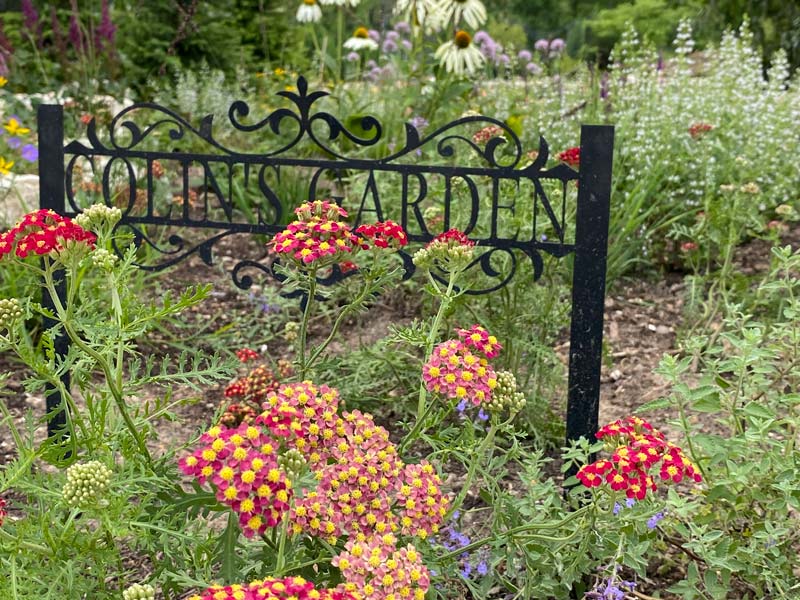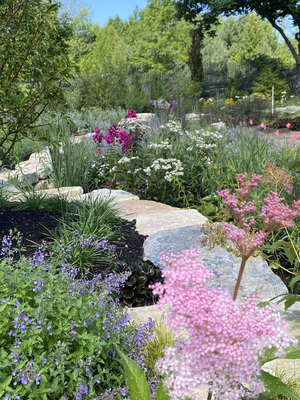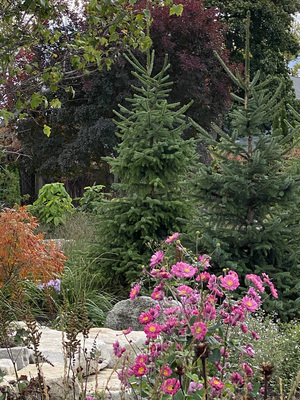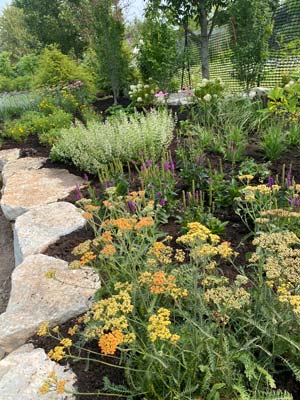The Secret Garden at Green Gables
The gardens at Green Gables have been admired for many years. Originally designed and planted more than a decade ago by local gardener Peter Buergen-Witt, whose other eye-catching creations can be seen outside the several Northern Door “Wild Tomato Pizza” locations, the gardens wrap attractively around the six houses of Green Gables, and incorporate a living evergreen arch, a pond, a fountain, and many varieties of showy perennials, ensuring the garden continually bursts with color and surprises throughout the growing season. In the spring, Iris, Allium, and Peonies provide a dazzling display. Summer highlights include tall phlox, bee balm, smoke-bush, coneflowers, and salvia. During the fall, the unique Door County afternoon light amplifies the soft blues of Russian sage, golden black-eyed Susan and the deep purples of flowering sedums. Passing drivers often pull into Green Gables simply so people can take selfies!

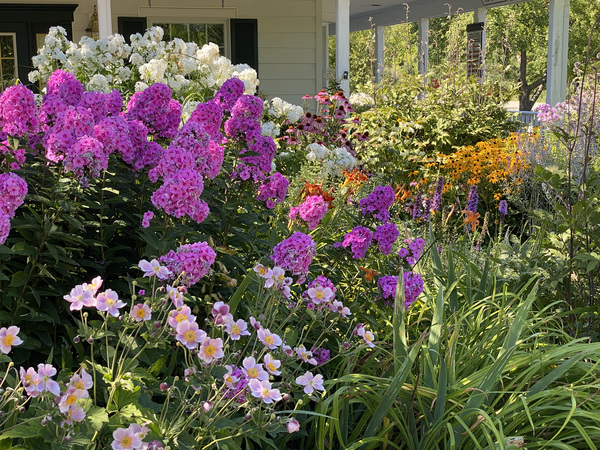

This might seem to be quite enough of a garden, but after a chance meeting with an expert horticulturist (who I’d engaged to inject some Ash trees to defend against a particularly destructive insect pest) I embarked upon an ambitious garden idea that would take it to a whole new level. This has already resulted in 18 months of ‘hard labor’, and the work will continue this year – but by 2023 it should all result in an arboretum-quality private garden that can be used for intimate events such as photoshoots, or for birthday/anniversary events rental, and small theatrical productions in a really special setting.



“Passing drivers often pull into Green Gables simply so people can take selfies here!”
After meeting famed Ashborer-beetle-killer Tom Wolfe, I quickly learned that for 34 years he had actually been the Head Gardener at no less than the Art Institute of Chicago. He now lives in Baileys Harbor, just a few miles from Green Gables. Together, we quickly began dreaming of ways to convert what was merely an open 1-acre field/lawn at the rear of the Green Gables property into a nature-inspired perennial garden, favoring native trees and prairie plants. After a quick test with one of the rusty spades that littered the garage, we found that we hit bedrock just one foot under the topsoil – not untypical in Door County, as we are located on the Niagara Escarpment. Aside from blasting, there is virtually no way to remove big chunks of bedrock, so we would have to raise all the plantable areas instead, providing enough depth for the root growth of any new trees. And so I began sketching out whimsical designs for a large series of raised flower beds, each of which would be contained within low walls of local fieldstone.
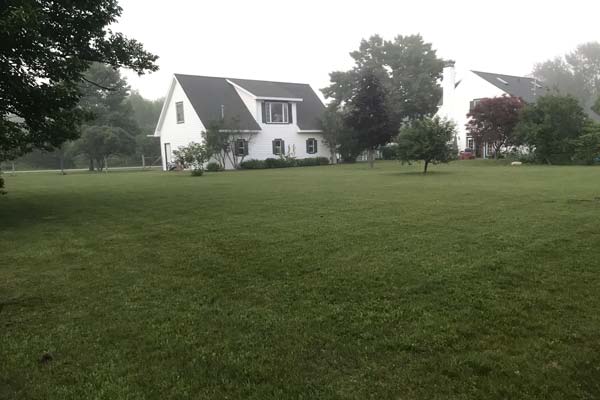
Like many of my practical endeavors in times past, my initial idea for the garden was a rather small and manageable one, but somehow, over time, this expanded exponentially, no doubt because of the many creative possibilities that later arose, and also because of the sheer fun of it! The Herculean project we now find ourselves engaged in is now pulling together fast! In the spring of 2022 irrigation will be installed, finally meaning I no longer must water for 4 hours each day with a hose. Later this season, turf will be laid (or seeded) to fill in the currently-missing lawn areas. A perimeter fence, new bathrooms, and a pretty entry gate are also on the wish-list. By 2023 we hope to share this rather special outdoor secret with everyone!
The project has had several distinct stages, and I’ve tried my hand at almost every aspect of it, joined (at various times) by friends and local helpers, all supervised by Tom (with occasional additional contributions from his own set of expert friends). Assigning this ambitious project to a landscape gardening firm (even if they had the know-how) would have been prohibitively costly, but from the beginning I saw this as a hands-on, personal project, anyway.
The first challenge was to clear the area, and so we chopped down several trees that were not doing so well, including a very large purple maple with girdled roots. We also removed one tree that was growing very happily: A giant invasive honeysuckle variety, normally considered a large shrub, but grown into a green monster, taller than the 2-story garage.
“By 2023 we hope to share this rather special outdoor secret with everyone!”
After I mastered a new (and highly satisfyingly) skill, chain-sawing, it wasn’t long before I was also regularly careening around the site behind the wheel of a John Deere tractor, or at the controls of one of several Skidsteers or Bobcats that we rented when needed. Heavy-lifting and digging equipment was essential as we’d need to move huge amounts of rocks and soil. Our local quarry, Hockers, started bringing in quarry stone by the truckload, 18 cubic yards at a time. I quickly exhausted their supply, and so they located another quarry 30 miles away who appeared to have enough stone to build the Pyramids – and that’s approximately the amount we needed! On several occasions, four of Hockers’ trucks drove down there in convoy, filled their trucks up using large front-loader machines, then returned to Green Gables to dump tons of blasted rock in pile after pile, ruining most of my lawns! One of us would then precariously pick through these rock heaps on foot, like a mountain goat with a tape-measure, to look for the perfect-sized specimen to haul off and add to our retaining walls. At the time of writing, we’ve introduced around 140 tons of soil and 240 tons of rock to the rear Green Gables garden – and there’s not a single one of those rocks that (at some point or other) was not lifted and positioned by hand!


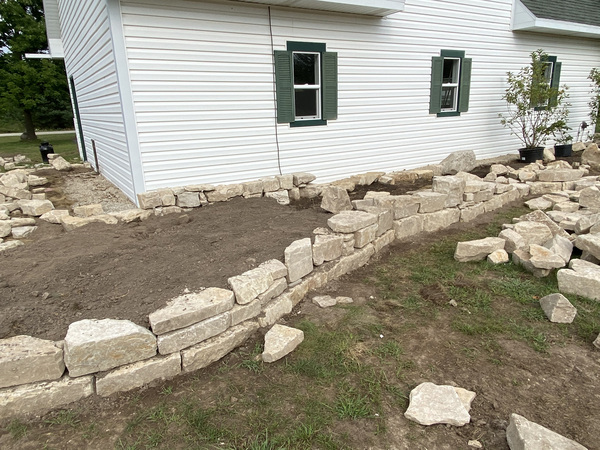

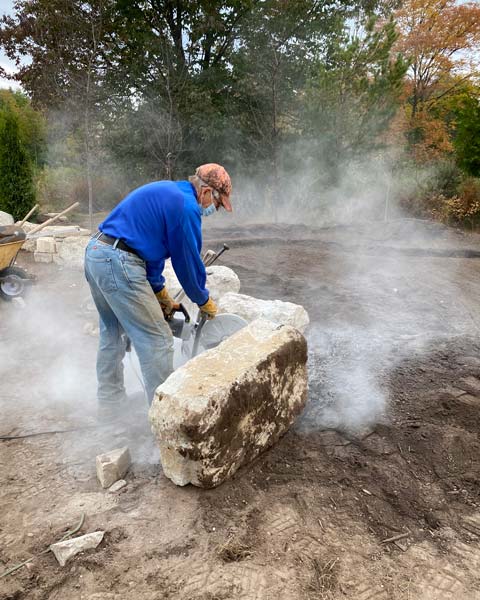
The technique for ‘dry-stacking’ stone walls (i.e. without the use of mortar) appears to be simple enough…until one actually tries it. The challenges quickly became obvious when we tried building our first wall of several courses with 100-pound rocks that rarely had flat sides and apparently had never heard of a right-angle! A small maintenance crew from Orchestra Hall in Chicago joined me on numerous weekends, and provided some much-needed extra muscle and enthusiasm. They also dished up delicious tortillas and a beer at the end of muddy 10-hour days. Neither they nor I had built walls like this before, but somehow we developed some zany (and effective) techniques – although it is remarkable that we all still have ten fingers. Under the instruction of local stone-smith Bob Kaminski (and by means of skid-steer, tractor, rolling cart, pry bar, ingenuity and sheer brawn) we managed to create about 50% of the raised beds by the end of 2020. At this point in time, the design of the remainder of the garden might have been anyone’s guess; it was, by then, almost impossible to remember what the place used to look like, or to see clearly beyond all the mud to what it might one day become.
Even though the raised beds were far from fully built, we wanted to get some plant material into the ground ASAP, so that the root system of young trees could begin getting established. Trees and their root balls are so heavy that we chose to plant many before any rock walls were constructed nearby, for moving them into their intended spot at a later stage might be almost impossible without difficulty or damage. In many cases, we ‘planted’ a 7-foot tree in its desired location by perching it on top of a large mound of well-mulched soil…..even though a surrounding garden bed did not yet exist. I learned that this method of ‘heeling them in’ is how professional nurseries store their trees (sometimes for many years) prior to sale or distribution. Many a lonely Green Gables tree was kept this way for months, watered by hand, until we finally filled in the surrounding area with soil, built retaining walls, and adding other plant material to keep it company.

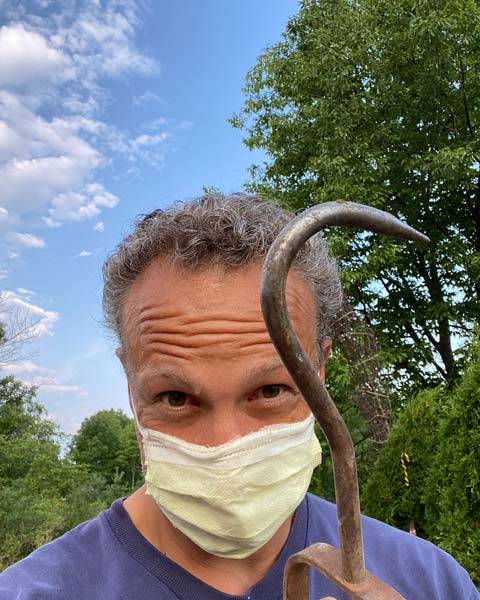
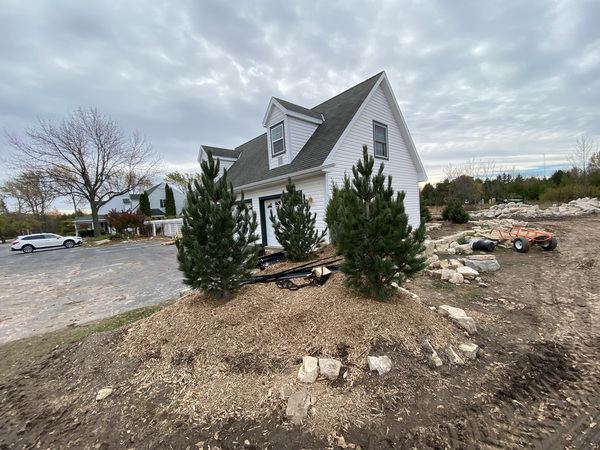
By the onset of Winter in 2020-21 the garden was a scene of apparent chaos: piles of rock, debris, mulch and new soil stood everywhere, punctuated by trees balanced on their own little islands within estuaries of mud – all enclosed by a distinctly homemade 400-ft snow fence of T-posts, plastic netting, and chicken-wire. Repairing wind-torn portions of this fence in sub-zero temperatures was soon to become my winter nightmare.
“After much deliberation (i.e. arguing) we’d chosen a stately European Weeping Beech tree for the garden entrance.”
We resumed work in early Spring 2021, with a goal of completing the physical infrastructure and planting the entire garden within the 2021 season. But first we had a surprise: After much deliberation (i.e. arguing) we’d chosen a stately European Weeping Beech tree for the garden entrance. We anticipated delivery of an 18-footer with a large root ball, from Johnson’s nursery in Illinois. Instead, the Beech that arrived was 28-feet tall (with a root ball 10 feet across and 5 feet high) weighing multiple tons! This magnificent specimen tree was obviously deserving of the spotlight, so there was a quick change of plan – and although it took a couple of hours, two large tractors and six guys (plus the inevitable near-accidents) we finally got it standing upright in a position where it would eventually serve as a true center-piece of the garden. Of course we then had to build a high rock wall around it and add several tons of soil; we also poured some huge concrete footings to which the tree will remain cabled for a few years until it fully takes root. This plant one grown from a single tiny seed turned into a 6-week project. Now all I have to do is keep it alive!

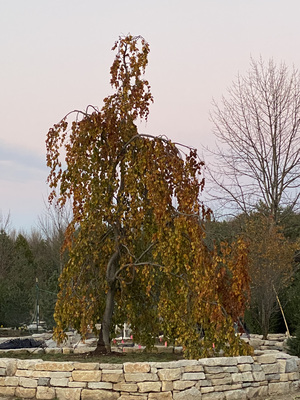
We spent the spring and early summer finishing the planting of 40 conifers of various varieties, including Serbian spruce and some very attractive Junipers. The stars of the conifer collection are twelve Swiss stone pines. We have not seen these elsewhere in Door County, though the climate suits them perfectly. The remainder of the 90+ trees and large shrubs include bottlebrush buckeye, red buckeye, Eastern redbud, musclewood, copper European beech, Canadian hemlock, sumac, serviceberry, fringetrees, fragrant viburnum, dogwood, hawthorns, and a variety of crabapples, flowering in pink, white and red, amazing in the spring.
“I sneakily shuffled Roy’s plants incessantly until I found color and form combinations I wanted”
Once the living ‘architecture’ of the garden had been established by the trees and shrubs, it was time for the perennials to be planted. Roy Diblik, a much-admired and published horticulturist, designed the plant layout and made numerous visits to Green Gables from his Illinois/Chicago-border nursery. In June, he arrived with his truck, and it was very exciting to see 2,000+ plants lined up on the ground ready to be placed in position, knowing there’d be at least as many again in the future! One of Roy’s special areas of expertise is in plant ‘families’ – creating gardens in which different plants cohabit well together – one group supplying another’s needs, with none asserting dominance over the other in the course of time. Roy also took into account the future growth of the trees and shrubs and how their lengthening shadows would eventually impact certain areas of the perennial beds. By midsummer, it became clear I needed more daily help, and so I was fortunate to find an experienced gardener for Green Gables, Luis, who then joined me each week for 10-hour days in the garden, each characterized by tragedies and triumphs!

By the end of the summer, despite the backdrop of the battered, makeshift perimeter fence that had remained in place, some areas of the garden were in full bloom, and looked beautiful. I sneakily shuffled Roy’s plants incessantly until I found color and form combinations I wanted. Other garden experts and growers visited during the summer, and expressed their enthusiasm, and so I gained additional input (and sometimes more plants) from them, too – and even the internationally-acclaimed designer of the Chicago Millennium Park Garden and New York’s ‘High Line’, Piet Oudorf, joined in. Piet is the leading figure in the popular “New Perennials” garden movement, and possibly the most famous garden designer in the world at present. He joined us on video-phone from his home in The Netherlands, while Tom gave him a video tour round this latest creation. Piet particularly liked the curves of my serpentine rock garden design!
The garden now features casual drifts of herbaceous perennials, many chosen for their form as well as for their color, and for their long-lasting visual interest, including (in some cases) a plant’s seed-heads, after its blooms have died off. Native perennials such as mint, verbena and salvia provide color contrast and backdrop to more dramatic flowering plants, of both familiar and unusual varieties, and often contribute a sweet scent. Bees are particularly attracted to the garden, and Monarch butterflies have definitely found their particular favorite spots. The final stage of planting took place in the fall of 2021, when I planted (individually, with the aid of an electric hand-drill) almost 20,000 spring bulbs. I created a vast electronic spreadsheet to chart the ordering and organization of the bulbs and their dispersement throughout the garden. In September and October this ridiculous-yet-strangely-satisfying bureaucratic operation filled the 1st floor of an entire building which quickly became known as “the Bulb Room.” Eventually the entire garden should absolutely burst with color in springtime. Dramatic Eremurus tubers, and many hundreds of Allium bulbs of multiple varieties were also planted, the largest of which will last well into the summer and sway above and within the summer-blooming perennials.
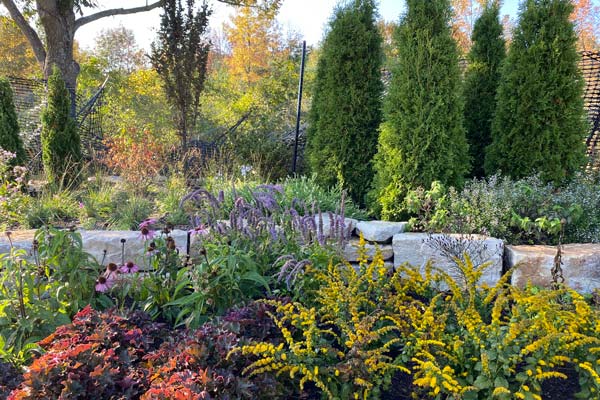
While all this rear garden work was happening in 2021 a thorough building renovation was also taking place just over the road, as I converted what had been a museum devoted to dog-sledding into my two new vacation homes, now named SPRUCE and APPLE. There was no real garden there at the time, and in fact, the plot of land was in a very unattractive state. So there we built yet more raised beds, and planted them in a similar style as the rear garden – with Hawthorn-, Fringe-, Dogwood- and Serviceberry trees, Junipers, and a couple of magnificent Cardinal Crabapples – plus a further 10,000 spring bulbs. Now that spring 2022 is upon us I am looking forward to seeing it in all its glory, and this year we’ll complete the garden there as we plant grass in the open areas and add one special cherry on the cake at the end of this month – a very large Fagus Sylvatica ‘Rohanii,” (Purple European Beech).


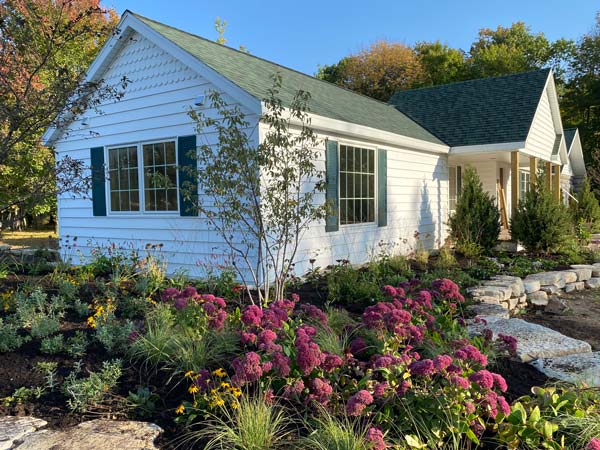
I hope that one day the Green Gables gardens will attract visitors from far and wide. Of course, everyone who stays here is welcome to enjoy it all – and to perhaps do some weeding, watering, or apple-gathering! When it is truly finished (or as finished as any garden ever can be) then it will become available for rental and events. In the meantime, I’ll keep updating this blog throughout 2022 as the garden nears completion. This will be an exciting year.
Thanks for reading, and I hope that you’ll one day enjoy Green Gables in person!
